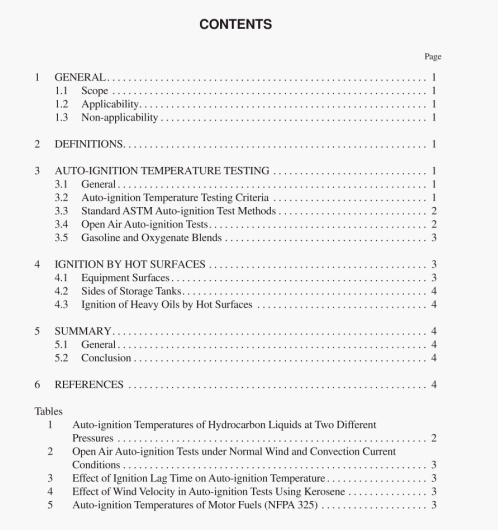API RP 2216:2003 pdf download.lgnition Risk of Hydrocarbon Liquids and Vapors by Hot Surfaces in the Open Air.
Hot-flame IgnItion: A rapid, self-sustaining, sometimes audible, gas phase reaction of a sample or its decomposition products with an oxidant usually accompanied by a readily visible yellow or blue flame. AlT is defined as the hot-flame reaction threshold temperature.
Cool-flame Ignition: A relatively slow, self-sustaining. barely luminous, gas phase reaction of the sample or its (lecomposition products with an oxidant. Cool Ilames are visible only in darkened areas. The Cool-flame Reaction Threshold CFT) is the lowest temperature at which cool Ilame ignitions are observed.
Pre-flame Ignition: A slow non-Iwninous, gas phase ft’action of the sample or its decomposition products with an oxidant that it is contacting. The Pre-flame Reaction Threshold (PRT) is the lowest temperature at which an exothermic gas reaction is observed.
The ignition temperatures that are typically reported in tlanuuable and combustible liquid hydrocarbon physical characteristic tables (such as in NFPA 325) arc similar to AlT values. However, because the CFT temperature and the PRT temperature are slightly lower than the AlT, both must be considered when assessing the ignition risk of a specific hydrocarbon and a particular system or potential exposure.
3.4 OPEN AIR AUTO-IGNITION TESTS
The occurrence of hydrocarbon vapor releases in open air constitutes conditions that are very different from those experienced in the standard ASTM laboratory ignition temperature tests described above. Because actual field conditions differ greatly from laboratory conditions, ignition of vapors in open air often requires suthice temperatures considerably different from published ignition temperatures of specific hydrocarbons.
3.4.1 Open Air tests
Small scale laboratory tests that were made on relatively unconfined butane/air (AlT 5SO’F 1287°CI) and gasoline/air (AlT 536’F 128(Y’CI) mixtures determined that metal sur1ces had to reach temperatures of approximately I 4(XY’F (760°C) before ignition occurred. A number of other. more realistic tests were made in open air where normal wind and convection currents were present. The results of these tests (see Table 2) were essentially the same ftr both hydrocarbon droplets sprayed on hot surfitces and for hydrocarbon vapor- air mixtures released at the hot surfaces and verified the results of the laboratory tests.
Another test method developed at the National Institute of Standards and Technology has been used to conduct short duration AlT measurements of hydrocarbon fuels under atmospheric pressure conditions. AITs were determined under steady flow conditions where the contact time between the controlled hydrocarbon/air mixture and the heated metal.
API RP 2216:2003 pdf download
